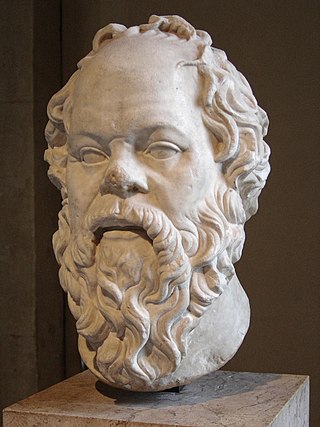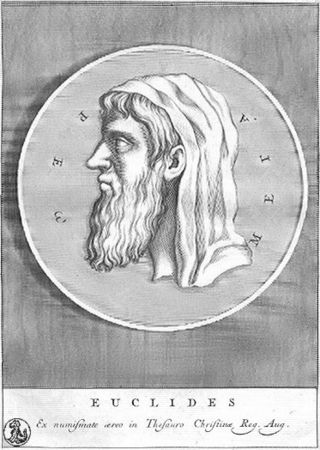In classical logic, disjunctive syllogism is a valid argument form which is a syllogism having a disjunctive statement for one of its premises.
In logic, the law of non-contradiction (LNC) states that contradictory propositions cannot both be true in the same sense at the same time, e. g. the two propositions "p is the case" and "p is not the case" are mutually exclusive. Formally, this is expressed as the tautology ¬(p ∧ ¬p). The law is not to be confused with the law of excluded middle which states that at least one, "p is the case" or "p is not the case", holds.
In logic, the law of excluded middle or the principle of excluded middle states that for every proposition, either this proposition or its negation is true. It is one of the three laws of thought, along with the law of noncontradiction, and the law of identity; however, no system of logic is built on just these laws, and none of these laws provides inference rules, such as modus ponens or De Morgan's laws. The law is also known as the law / principleof the excluded third, in Latin principium tertii exclusi. Another Latin designation for this law is tertium non datur or "no third [possibility] is given". In classical logic, the law is a tautology.
In logic, proof by contradiction is a form of proof that establishes the truth or the validity of a proposition, by showing that assuming the proposition to be false leads to a contradiction. Although it is quite freely used in mathematical proofs, not every school of mathematical thought accepts this kind of nonconstructive proof as universally valid.

A syllogism is a kind of logical argument that applies deductive reasoning to arrive at a conclusion based on two propositions that are asserted or assumed to be true.

In traditional logic, a contradiction occurs when a proposition conflicts either with itself or established fact. It is often used as a tool to detect disingenuous beliefs and bias. Illustrating a general tendency in applied logic, Aristotle's law of noncontradiction states that "It is impossible that the same thing can at the same time both belong and not belong to the same object and in the same respect."

A mathematical proof is a deductive argument for a mathematical statement, showing that the stated assumptions logically guarantee the conclusion. The argument may use other previously established statements, such as theorems; but every proof can, in principle, be constructed using only certain basic or original assumptions known as axioms, along with the accepted rules of inference. Proofs are examples of exhaustive deductive reasoning which establish logical certainty, to be distinguished from empirical arguments or non-exhaustive inductive reasoning which establish "reasonable expectation". Presenting many cases in which the statement holds is not enough for a proof, which must demonstrate that the statement is true in all possible cases. A proposition that has not been proved but is believed to be true is known as a conjecture, or a hypothesis if frequently used as an assumption for further mathematical work.

The sorites paradox is a paradox that results from vague predicates. A typical formulation involves a heap of sand, from which grains are removed individually. With the assumption that removing a single grain does not cause a heap to become a non-heap, the paradox is to consider what happens when the process is repeated enough times that only one grain remains: is it still a heap? If not, when did it change from a heap to a non-heap?
In classical logic, intuitionistic logic and similar logical systems, the principle of explosion, or the principle of Pseudo-Scotus, is the law according to which any statement can be proven from a contradiction. That is, from a contradiction, any proposition can be inferred; this is known as deductive explosion.

Euclid of Megara was a Greek Socratic philosopher who founded the Megarian school of philosophy. He was a pupil of Socrates in the late 5th century BC, and was present at his death. He held the supreme good to be one, eternal and unchangeable, and denied the existence of anything contrary to the good. Editors and translators in the Middle Ages often confused him with Euclid of Alexandria when discussing the latter's Elements.
Absurdity is a state or condition of being unreasonable, meaningless, or so unsound as to be irrational. "Absurd" is the adjective used to describe absurdity, e.g., "Tyler and the boys laughed at the absurd situation." It derives from the Latin absurdum meaning "out of tune". The Latin surdus means "deaf", implying stupidity. Absurdity is contrasted with being realistic or reasonable In general usage, absurdity may be synonymous with nonsense, meaninglessness, fancifulness, foolishness, bizarreness, wildness. In specialized usage, absurdity is related to extremes in bad reasoning or pointlessness in reasoning; ridiculousness is related to extremes of incongruous juxtaposition, laughter, and ridicule; and nonsense is related to a lack of meaningfulness. Absurdism is a concept in philosophy related to the notion of absurdity.
Logic is the formal science of using reason and is considered a branch of both philosophy and mathematics and to a lesser extent computer science. Logic investigates and classifies the structure of statements and arguments, both through the study of formal systems of inference and the study of arguments in natural language. The scope of logic can therefore be very large, ranging from core topics such as the study of fallacies and paradoxes, to specialized analyses of reasoning such as probability, correct reasoning, and arguments involving causality. One of the aims of logic is to identify the correct and incorrect inferences. Logicians study the criteria for the evaluation of arguments.
A premise or premiss is a proposition—a true or false declarative statement—used in an argument to prove the truth of another proposition called the conclusion. Arguments consist of a set of premises and a conclusion.

Trivialism is the logical theory that all statements are true and that all contradictions of the form "p and not p" are true. In accordance with this, a trivialist is a person who believes everything is true.
Connexive logic is a class of non-classical logics designed to exclude the paradoxes of material implication. The characteristic that separates connexive logic from other non-classical logics is its acceptance of Aristotle's thesis, i.e. the formula,
In logic, specifically in deductive reasoning, an argument is valid if and only if it takes a form that makes it impossible for the premises to be true and the conclusion nevertheless to be false. It is not required for a valid argument to have premises that are actually true, but to have premises that, if they were true, would guarantee the truth of the argument's conclusion. Valid arguments must be clearly expressed by means of sentences called well-formed formulas.
Stoic logic is the system of propositional logic developed by the Stoic philosophers in ancient Greece.

Logic is the study of correct reasoning. It includes both formal and informal logic. Formal logic is the science of deductively valid inferences or logical truths. It studies how conclusions follow from premises due to the structure of arguments alone, independent of their topic and content. Informal logic is associated with informal fallacies, critical thinking, and argumentation theory. It examines arguments expressed in natural language while formal logic uses formal language. When used as a countable noun, the term "a logic" refers to a logical formal system that articulates a proof system. Logic plays a central role in many fields, such as philosophy, mathematics, computer science, and linguistics.









